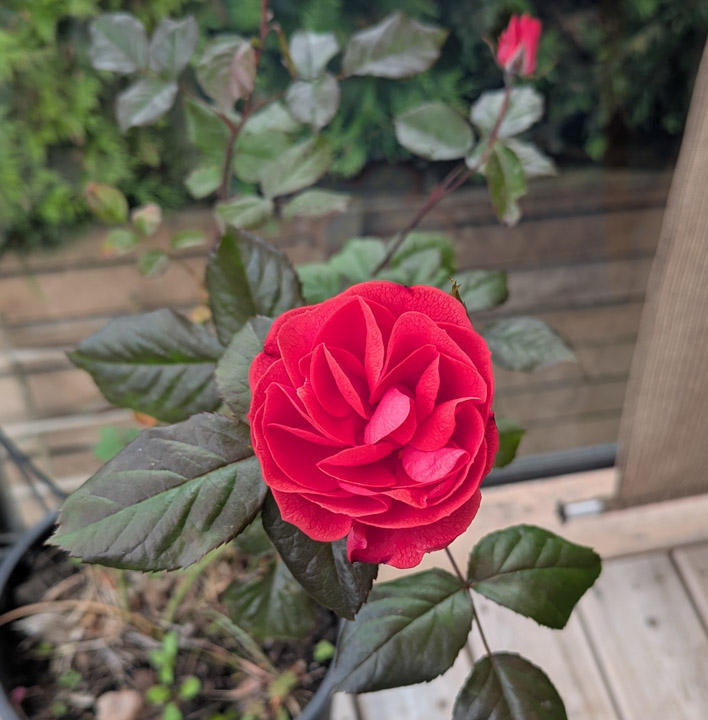
Perfectly Different Colors

This considers how two modern cameras handle a difficult color challenge, illustrated by photos of a perfect rose and a piano.
We moved into our former place in January 1997 and, that summer, discovered the property included this slender little rose that only had a couple blossoms every year, but they were perfection, beautifully shaped and in a unique shade of red I’d never seen anywhere else (and still haven’t). Having no idea of its species, we’ve always called it “our perfect rose”.
So when we moved last year, we took the rose with us. It seems to like the new joint, has a blossom out and two more on the way and it’s still May.
I was looking at it this morning and it occurred to me that its color might be an interesting challenge to the two fine cameras I use regularly, namely a Google Pixel 7 and a Fujifilm X-T5.
First the pictures.
Limitations · First of all, let’s agree that this comparison is horribly flawed. To start with, by the time the pixels have made it from the camera to your screen, they’ve been through Lightroom, possibly a social-media-software uploader and renderer, and then your browser (or mobile app) and screen contribute their opinions. Thus the colors are likely to vary a lot depending where you are and what you’re using.
Also, it’s hard to get really comparable shots out of the Pixel and Fuji; their lenses and processors and underlying architectures are really different. I was going to disclose the reported shutter speeds, aperture, and ISO values, but they are so totally non-comparable that I decided that’d be actively harmful. I’ll just say that I tried to let each do its best.
I post-processed both, but limited that to cropping; nothing about the color or exposure was touched.
And having said all that, I think the exercise retains interest.
Which? · The Pixel is above, the Fuji below.
The Pixel is wrong. The Fuji is… not bad. The blossom’s actual color, to my eye, has a little more orange than I see in the photo; but only a little. The Pixel subtracts the orange and introduces a suggestion of violet that the blossom, to my eye, entirely lacks.
Also, the Pixel is artificially sharpening up the petals; in reality, the contrast was low and the shading nuanced; just as presented by the X-T5.
Is the Pixel’s rendering a consequence of whatever its sensor is? Or of the copious amount of processing that contributes to Google’s widely-admired (by me too) “computational photography”? I certainly have no idea. And in fact, most of the pictures I share come from my Android because the best camera (this is always true) is the one you have with you. For example…
That same evening we took in a concert put on by the local Chopin Society featuring 89-year-old Mikhail Voskresensky, who plays really fast and loud in an old super-romantic style, just the thing for the music: Very decent Beethoven and Mozart, kind of aimless Grieg, and the highlight, a lovely take on Chopin’s Op. 58 Sonata, then a Nocturne in the encores.
Anyhow, I think the Camera I Had With Me did fine. This is Vancouver’s oldest still-standing building, Christ Church Cathedral, an exquisite space for the eyes and ears.
Maybe I’ll do a bit more conscious color-correction on the Pixel shots in future (although I didn’t on the piano). Doesn’t mean it’s not a great camera.
Comment feed for ongoing:
From: Roland Tanglao (Jun 01 2025, at 19:53)
cameras lie :-) i am just at the point where i am playing get the best camera "lie" in the moment. i.e. Straight out of camera jpeg or bust :-)
[link]
From: Don Kirkby (Jun 03 2025, at 12:26)
The cathedral is only the oldest still-standing building in downtown Vancouver. Vancouver's oldest still-standing building is the Old Hastings Mill Store museum at the north end of Alma Street. It was built about 30 years before the cathedral at the foot of Dunlevy Street, then barged to Point Grey when it was about to be demolished in the 1920s.
https://hastingsmillmuseum.ca/our-history
[link]
From: Paul Boddie (Jun 17 2025, at 04:00)
My Fujifilm F31fd with the classic SuperCCD technology always seemed to struggle to represent pure reds, as far as I remember now. So, I looked up my old pictures and actually found an image of a red flower.
Indeed, the colour reproduction of my image more resembles that of your second image and helps me put a finger on what I found less than ideal at the time. Although the red in my image is saturated, the rendition of the tones is flat, and the saturation makes the flower seem unreal, almost like a wax stamp on the image itself!
I never used any film simulation modes with the F31fd, and I think there was only one - chrome? - anyway. Output was always JPEG. So, I wasn't boosting the colour for what some might call "Canon colours".
Fujifilm were probably onto something with their SuperCCD technology for better dynamic range, which is where the S5 was apparently prized by wedding photographers, according to the folklore. In comparison, I think that X-Trans was rather regarded with skepticism as an underwhelming attempt at differentiation.
[link]